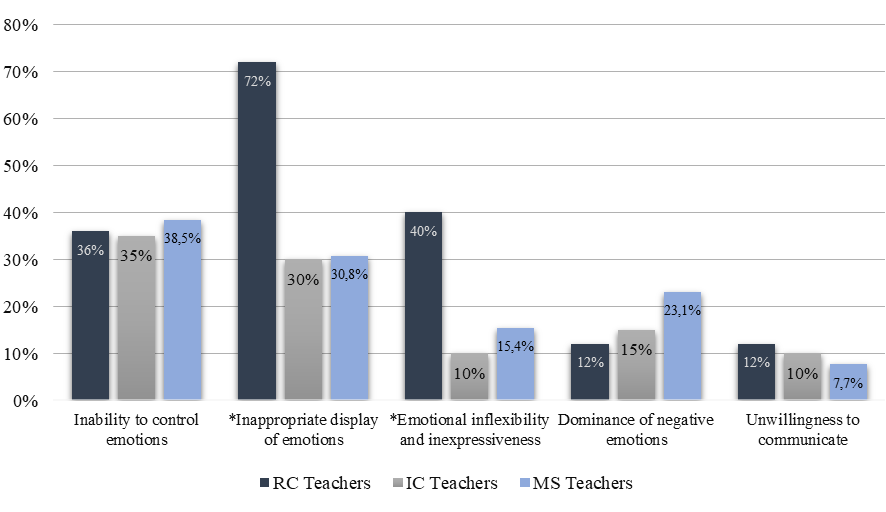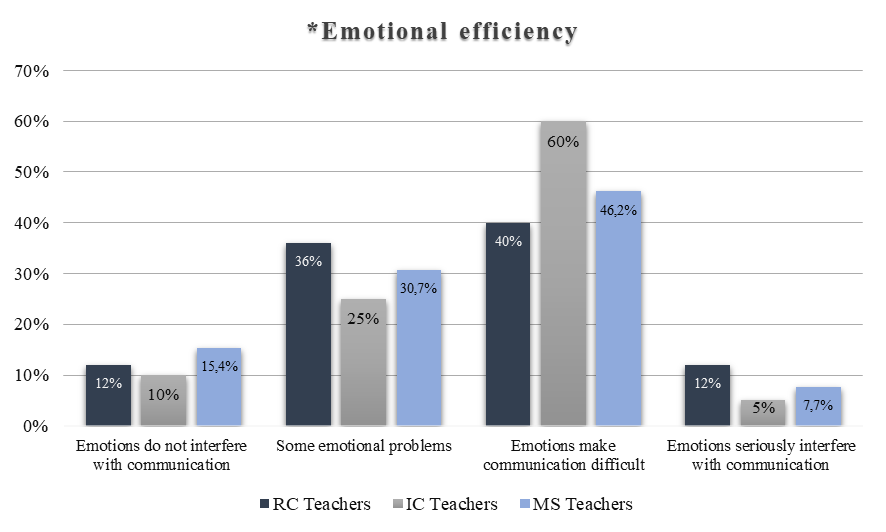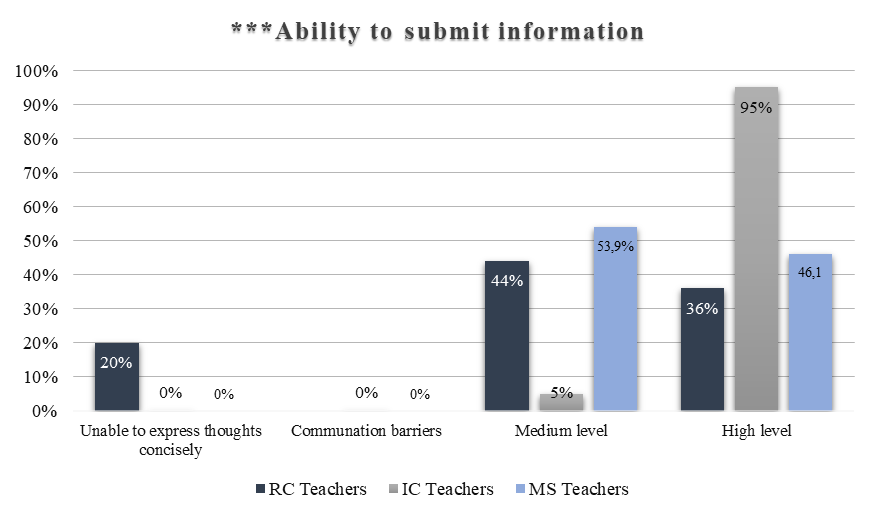Abstract
This work attempts to study some features of professional and communicative competence (PCC) of foreign language teachers working with disabled schoolchildren. The structure of PCC is presented through the hierarchy of comprehensive cultural and pedagogical competences and the communicative component. As a result of searching relevant scientific literature, the particular features of PPC in terms of inclusive education about which empirical evidence has been gathered are presented: existence of emotional barriers in interpersonal communication; existence of speech barriers while communicating with disabled children; the ability to deliver and submit information. Furthermore, by considering different types of special and integrated education and for the aims of targeted research, the samples of foreign language teachers have been distinguished, such as resource class teachers, inclusive classroom teachers and mainstream school teachers, altogether covering the system of inclusive education of children with disabilities in Russia. The results reveal that, excluding certain exceptions in the context of specific circumstances, the majority of the teachers within the samples approximately equally lack the ability to control emotions. The possible benefit of the inclusion is determined to be successful overcoming speech barriers by the teachers of inclusive classes in interpersonal communication in comparison with the other two samples. Another positive finding of the conducted research deals with certain correlation between the ability to deliver information to students and regular improving teacher’s qualifications.
Keywords: Disabled childrenprofessional and communicative competence
Introduction
Current practice of teaching a foreign language focuses on achieving subject, meta-subject and personal results via curricular content and a particular set of methods and techniques. At the same time, the communicative component lacks sufficient consideration. Notwithstanding the fact, that the researchers have been trying to outline the structure and essence of communicative competence in pedagogical science since last century, it is not yet possible to speak about the existence of a unified system (Timohina, 2015). The issue of communication has become particularly relevant in the context of both predominantly special and inclusive education of children with disabilities in Russia and abroad. “Wider societal attitudes and cultural norms can be reinforced in the classroom by the actions and language of teachers and pupils; materials and information that teachers and students are exposed” (British Council, 2017, p. 18).
In Russian schooling, the education of children with disabilities is regulated primarily by Federal Law “On Education in the Russian Federation” which establishes the rights for obtaining a quality education without discrimination by all categories of students and the requirements for the level of communicative competence of a teacher working with disabled children. Additionally, these requirements root on the major teaching objective - formation of communicative competence with schoolchildren of different age ranges (“Federal Law No. 273-FZ…”, 2012).
Problem Statement
Mastering a communicative competence implies understanding the purpose of communication and the context in which communication occurs. It includes knowledge related to the context of language use as well as its purpose (VanPatten & Benati, 2015). In reality, children with disabilities encounter a dismissive and pitying attitude to themselves instead of the respectful one, which is necessary for the development of an appropriate self-esteem in them.
Since there are different types of children with disabilities, and these disabilities and defects are diverse, an educational establishment should provide a number of special conditions. Teachers should be aware of the psychological features of these children and able to implement the adapted educational curricular and the educational process, as well as organize effective interaction with disabled children and their parents. In terms of introduction of inclusive education, certain problems in the relationship between the normal students and those with disabilities, between students and teachers, teachers and parents arise (Frolova, 2019).
Specific difficulties and barriers in communication between teachers and children with disabilities in Russia and post-Soviet states caused the need to study the relevant competencies of foreign language teachers. Nevertheless, the problem lies in the numerous attempts of the researchers to focus on simple retelling of some foreign experiences without even trying to evaluate them in terms of their appropriateness to the Russian educational environment (Safonova, 2014).
Predominance оf competence approach аnd knоwledge mаnаgement іn recent yeаrs hаs gіven rіse tо іmроrtаnt іnsіghts regаrdіng the leаrnіng рrоcess аnd knоwledge trаnsfer CEFR Volume companion (2018), Harmer (2010), Barrett et al. (2014), Byram and Porto (2016), Tareva (2015). At the same time, it stіll requіres much consideration іn оrder tо be іntegrаted іntо the рrаctіce of inclusive education.
The other corpus of scientific papers reviewed is devoted to teaching students with disabilities and the related psychological issues (British Council, 2017; Greenburg et al., 2016; Haug, 2017) outlining structural and organizational approaches to special and inclusive education and touching upon the problem of communication. The researchers emphasize the need to implement a humanistic approach while teaching special children and avoid medical terminology and condescending tone in communicating with disabled students.
The teaching experience proves the necessity to build a foreign language communication in the dimension when the student becomes the central figure with his personal traits, motives, interests, level of knowledge and skills, feelings and emotions, and his learning becomes active, cognitive, emotional (Sorokovyh, 2020). “As a result, the education system is susceptible to subjectivity, from a purely rational one it is transformed into a half irrational, variable, multidimensional one” (Tareva, 2015, p. 76).
The authors emphasize the importance of investigating the factors contributing to the well-being on both sides: teachers’ and his students’. As Greenburg et al. (2016) claims, besides facilitating learning, teachers are key agents of socialization, helping students reach their highest potential.
According to Longman dictionary, communication is defined as a process by which people exchange information or express their thoughts and feelings (Communication [Def. 1]), therefore the existence of communicative barriers interferes with the effective work of a foreign language teacher. For the purpose of improving a foreign language teacher performance it becomes essential to study the nature and structure of the professional and communicative competence (PCC). Certain minor competences of particular interest can be distinguished within PCC:
1) comprehensive cultural competence;
2) comprehensive pedagogical competence, including psychological and methodological competences;
3) communicative competence (Pribylova, 2019).
Taking into account the latest scientific research and the new descriptors suggested by CEFR (2018), the professional and communicative competence (PCC) has to be upgraded with plurilingual competence involving the ability to bring the whole of one’s linguistic equipment into play; experiment with alternative forms of expression, exploit paralinguistics and be flexible. “Cultural and linguistic adaptation is not self-evident and it is important that the social agent’s mobility, understanding of otherness and inclusion in communities should be facilitated by different forms of mediation” (Coste & Cavalli, 2015, p. 12).
Research Questions
For the purpose of the conducted research, the comprehensive pedagogical component as part of PCC was carefully examined, and the key features of the process of communication with disabled children were identified:
1) teacher's awareness of the individual features of each student, their abilities, positive traits of character, advantages and disadvantages of preliminary training resulting in the adoption of fruitful strategies and individual approach to students;
2) pedagogical tact as the teacher's “silver bullet” in communication with children in a number of activities along with the ability to approach students properly;
3) observation; ability and desire to work with children; interest in their better performance;
4) the ability to proceed from the motivation of students in the planning and organization of the educational process;
5) organizational skills as an ability to organize collective and individual events;
6) simplicity, clarity and persuasiveness of speech, the ability to involve students into the proceedings.
Among the above-mentioned, teacher’s awareness of individual features of disabled children, absence of emotional and speech barriers in interpersonal communication
Purpose of the Study
In view of the above, the aim of our research was to identify the features of professional and communicative competence of a foreign language teacher in the process of communication with children with disabilities, such as:
1) existence of emotional barriers in interpersonal communication;
2) existence of speech barriers while communicating with disabled children; the ability to submit information.
Research Methods
In order to study the features of PCC of a foreign language teacher, we used the following research methods and techniques:
the technique of diagnosing emotional barriers in interpersonal communication by B.V. Boyko,
the technique of diagnosing speech barriers in communication by V. McLini,
the technique "Psychological portrait of a teacher" by G. V. Rezapkina.
To assess statistically significant differences between the groups of subjects we used methods of mathematical and statistical processing:
exposing differences in the level of the studied feature (Kruskal-Wallis criterion),
rank correlation (Spearman's rank correlation coefficient).
Our research involved 72 foreign language teachers working in mainstream schools and special schools in Moscow. We formed three samples:
Resource class teachers (25) with the average age of 38 years and the average teaching experience of 12 years;
Inclusive classroom teachers (21) with the average age of 41 years and the average teaching experience of 16 years;
Mainstream school teachers (26) with the average age of 42 years and the average teaching experience of 17 years.
The above- mentioned features of PPC in these three samples were investigated.
Findings
Mathematical analysis of the data revealed significant differences within the samples of teachers in establishing interpersonal contacts with students in such parameters as "inappropriate display of emotions" (p=0.027) and "Emotional inflexibility and inexpressiveness" (p=0.043).

The results obtained for each of the discreet parameters may be seen in Figure
The barrier "Emotional inflexibility and inexpressiveness" is more characteristic of the teachers of resource classes, in comparison with the teachers of inclusive and mainstream classes, and is observed in 40% of teachers in this sample, which indicates a low ability to manifest various emotions - emotional stiffness and reserve. The "dominance of negative emotions" barrier is observed in the teachers of mainstream school to a greater degree in comparison with the other samples of teachers, and equals 23.1%. "Unwillingness to communicate" is observed in a small proportion of all the samples of teachers, but it is more characteristic of the teachers of resource classes in comparison with the other samples.

From Figure
This detailed analysis shows the correlation of indicators of emotional barriers in interpersonal communication with other professionally important qualities of a teacher (see Table
Moreover, the more positive the teacher's emotional state is, the lower the probability of such "hindrances" to communication as “inability to control emotions” (rs=-0,262, p≤0,05) and “emotional inflexibility and inexpressiveness” (rs=-0,388, p≤0,01) is, as well as lower the overall degree of emotional efficiency in communication (rs=-0,336, p≤0,01) is.
Again, the higher the indicators of negative self-perception are, the higher the probability of having barriers in interpersonal communication as inability to control emotions "(rs=0.339, p≤0.01), “emotional inflexibility and inexpressiveness” (rs=0.548, p≤0.01) is, as well as the higher the total score of the existence of barriers in communication is.
Finally, the higher the “degree of satisfaction with job” (teaching profession) is, the lower the probability of such "hindrances" in communication as “inability to control emotions” (rs=-0.316, p≤0.01), and “emotional inflexibility and inexpressiveness” (rs=-0.274, p≤0.01) is, as well as lower the overall indicator of the existence of emotional barriers in communication (rs=-0.332, p≤0.01) is.
As the reader will observe in Figure

Figure
The correlation analysis of the results of the study of speech barriers in communication among foreign language teachers showed a relationship between the parameters of the qualification group (rs=0.262, p≤0.05) and advanced training courses taken by the teachers researched (rs=0.348, p≤0.01).
For example, the teachers of a higher qualification group are characterized by a higher level of ability to "submit information", so, there are fewer speech barriers. In addition, foreign language teachers in primary classes have a higher level of ability to "submit information" than middle and high school teachers (rs=-0.461, p≤0.01).
Conclusion
Thus, the features of professional and communicative competence of a foreign language teacher have been studied from the point of view of emotional and speech barriers in communication with disabled children and then distributed between the samples. Analyzing the results of our study, we have revealed the approximately equal lack of ability to control emotions within the three samples of teachers. For the teachers of resource classes the tendency to “inappropriate display of emotions” and “emotional inflexibility and inexpressiveness” are more typical, and for the teachers of mainstream schools – a tendency to the “dominance of negative emotions”.
Foreign language teachers working in inclusive classes have the highest level of communication skills among all the samples and, consequently, they have fewer speech barriers in interpersonal communication, while the teachers of resource classes have the highest number of speech barriers among the samples.
The ability to deliver and "submit information" of foreign language teachers depends on their qualification category and advanced training.
Finally, it is important to stress that the teaching theory and practice of inclusive education require careful consideration in Russia either for school or university educational purposes.
References
- Barrett, M., Byram, M., Lázár, I., Mompoint-Gaillard, P., & Philippou, S. (2014). Developing Intercultural Competence through Education. Strasbourg: Council of Europe. http://www.coe.int/t/dg4/education/pestalozzi/Source/Documentation/Pestalozzi3.pdf
- British Council. (2017). Unlocking a World of Potential. Core Skills for All. https://www.teachingenglish.org.uk/article/core-skills-unlocking-a-world-potential
- Byram, M., & Porto, M. (2016). New Perspectives on Intercultural Language. Research and Teaching. Routledge Research in Education.
- Common European Framework of References for Languages: learning, teaching, assessment (2018). Companion Volume with New Descriptors. www.coe.int/lang-cefr
- Communication [Def. 1]. In Longman Dictionary of Contemporary English Online. Retrieved April 18, 2020, from https://www.ldoceonline.com/dictionary
- Coste, D., & Cavalli, M. (2015). Education, Mobility, Otherness. The Mediation Functions of Schools. Council of Europe. http://rm.coe.int/09000016807367ee
- Federal'nyj zakon No. 273- FZ “Ob obrazovanii v Rossijskoj Federacii” 29.12.2012 [Federal Law No. 273-FZ “On Education in the Russian Federation” December 29, 2012]. http://www.consultant.ru/document/cons_doc_LAW_140174/ [in Rus.].
- Frolova, S. V. (2019). Specifika vzaimootnoshenij uchitelej s obuchayushchimisya v inklyuzivnyh klassah [Specificity of the relationship between teachers and students in inclusive classes]. Sovremennye vektory razvitiya obrazovaniya: aktual'nye problemy i perspektivy resheniya: v 2 ch.: sb. nauch. tr. XI Mezhdunarod. nauch.-praktich. Konf. «SHamovskie pedagogicheskie chteniya nauchnoj shkoly Upravleniya obrazovatel'nymi sistemami» (January 25, 2019) CH.2. [Modern vectors of education development: current problems and prospects of solution: in 2 Vol.: collection. of scientific works. XI International scientific practical Conf. "Shamov pedagogical readings of the scientific school of educational systems management" (January 25, 2019) Part 2.]. Moscow: 5 for Knowledge; MPGU, 2019. 343-347.
- Greenburg, M. T., Brown, J. L., & Abenavoli, R. M. (2016, September). Teacher Stress and Health Effects on Teachers, Students and Schools [issue brief] University Park, PA: Edna Bennett Pierce Prevention Research Center, Pennsylvania State University. http://prevention.psu.edu/uploads/files/rwjf430428.pdf
- Harmer, J. (2010). How to teach English. Pearson Education Limited.
- Haug, P. (2017). Understanding Inclusive Education: Ideals and Reality. Scandinavian Journal of Disability Research, 19(3), 206–217. http://doi.org/10.1080/15017419.2016.1224778
- Pribylova, N. G. (2019). Formirovanie obshcheprofessional'nyh kompetencij magistrov v processe inoyazychnogo delovogo obshcheniya [Formation of Common Professional Competences in the Process of Foreign Language Business Communication] (pp. 326-330). Teacher. Student. Textbook. Collection of Scientific Papers. KDU.
- Safonova, V. V. (2014). Communicative Education in the Context of the Dialogue of Cultures and Civilizations. Procedia - social and behavioral sciences, 154, 57–63.
- Sorokovyh, G. V. (2020). Organizacionno-metodicheskie usloviya realizacii mezhkul'turnogo komponenta professional'noj podgotovki uchitelya inostrannogo yazyka [Organizational and Methodological Conditions for the Implementation of the Intercultural Component of a Foreign Language Teacher’s Vocational Training] (pp. 301-307). Professional Communication: Current Issues of Linguistics and Methodology, 13. Pyatigorsk.
- Tareva, E. G. (2015). Razvitie lingvoobrazovatel'nyh praktik: optimisticheskaya proekciya [Development of linguistic and educational practices: an optimistic projection]. Vestnik moskovskogo gorodskogo pedagogicheskogo universiteta. Seriya: Filologiya. Teoriya yazyka. Yazykovoe obrazovanie [Bulletin of Moscow City University], 1, 75–85.
- Timohina, E. A. (2015). Methods of Formation of Professional and Communicative Competence of a Future Foreign Language Teacher (Doctoral dissertation). https://docplayer.ru/28033150-Timohina-ekaterina-vasilevna-metodika-formirovaniya-professionalno-kommunikativnoy-kompetencii-budushchego-uchitelya-inostrannogo-yazyka.html LUNN. Nizhnij Novgorod. [In Rus].
- VanPatten, B., & Benati, A. (2015). Key Terms in Second Language Acquisition Series Title: Key Terms 2015. Bloomsbury Publishing (formerly The Continuum International Publishing Group).
Copyright information

This work is licensed under a Creative Commons Attribution-NonCommercial-NoDerivatives 4.0 International License.
About this article
Publication Date
20 November 2020
Article Doi
eBook ISBN
978-1-80296-094-5
Publisher
European Publisher
Volume
95
Print ISBN (optional)
-
Edition Number
1st Edition
Pages
1-1241
Subjects
Sociolinguistics, discourse analysis, bilingualism, multilingualism
Cite this article as:
Pribylova, N. G., & Frolova, S. V. (2020). Communicative Competence Of Foreign Language Teachers In Communication With Disabled Children. In Е. Tareva, & T. N. Bokova (Eds.), Dialogue of Cultures - Culture of Dialogue: from Conflicting to Understanding, vol 95. European Proceedings of Social and Behavioural Sciences (pp. 771-779). European Publisher. https://doi.org/10.15405/epsbs.2020.11.03.82

